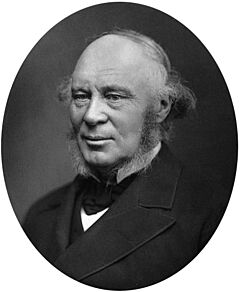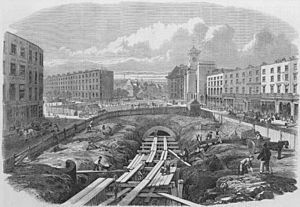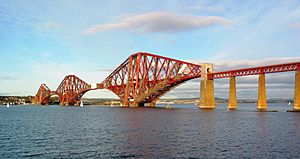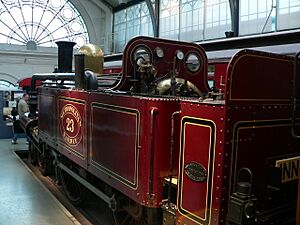Sir John Fowler, 1st Baronet facts for kids
Quick facts for kids
John Fowler
|
|
|---|---|
 |
|
| Born | 15 July 1817 Wadsley, Sheffield, West Riding of Yorkshire, England
|
| Died | 20 November 1898 (aged 81) Bournemouth, Hampshire, England
|
| Occupation | Engineer |
| Engineering career | |
| Discipline | Civil engineer |
| Institutions | Institution of Civil Engineers (president) Institution of Mechanical Engineers |
| Projects | Metropolitan Railway Millwall Dock Forth Bridge (A) Manchester Central (II*) Wicker Arches (II*) Torksey Viaduct (II*) |
| Significant design | Fowler's Ghost fireless locomotive |
Sir John Fowler (born July 15, 1817 – died November 20, 1898) was a famous English civil engineer. He was known for building railways and the structures needed for them.
In the 1850s and 1860s, he was the engineer for the world's first underground railway. This was London's Metropolitan Railway. It was built using a method called "cut-and-cover" under city streets. Later, in the 1880s, he was the main engineer for the amazing Forth Bridge. This bridge opened in 1890. John Fowler had a long and important career. He helped build many railways in Britain and other countries. He was also the youngest president of the Institution of Civil Engineers. His work left a lasting mark on Victorian engineering.
Contents
Early Life and Training
John Fowler was born in Wadsley, Sheffield, England. His father, also named John Fowler, was a land surveyor. Young John was taught at home at Whitley Hall.
He learned engineering from John Towlerton Leather. He also worked with George Leather on canals and railway surveys. In 1837, he joined John Urpeth Rastrick to work on railway projects. These included the London and Brighton Railway.
By 1841, he was the engineer for the Stockton and Hartlepool Railway. He started his own engineering business in Yorkshire. Because he had so much work, he moved to London in 1844. He became a member of the Institution of Mechanical Engineers in 1847. In 1849, he joined the Institution of Civil Engineers. In 1850, he married Elizabeth Broadbent. They had four sons.
Building Railways
John Fowler's engineering business became very busy. He worked on many railway plans across Britain. He became the chief engineer for the Manchester, Sheffield and Lincolnshire Railway. He also worked on the East Lincolnshire Railway and the Severn Valley Railway.
In 1853, he became the chief engineer for the Metropolitan Railway in London. This was the world's first underground railway! It was built using the "cut-and-cover" method. This meant digging shallow trenches under roads. The line opened in 1863 between Paddington and Farringdon.
Fowler also designed the District Railway and the Hammersmith and City Railway. Today, these lines are part of the London Underground's Circle line. For his work on the Metropolitan Railway, Fowler was paid a very large sum of money.
He also helped design major train stations. These included Victoria station in London and Manchester Central station. The roof of Manchester Central station was one of the widest iron arches in Britain.
Fowler's work wasn't just in Britain. He advised on railway projects in many countries. These included Algeria, Australia, Egypt, and France. In Egypt, he worked on plans for a railway to Khartoum in Sudan. He also gave advice on railway track sizes in India and Australia. Later, he worked on London's first deep underground lines. These were the City and South London Railway and the Central London Railway.
Designing Bridges
As part of his railway projects, Fowler designed many bridges. In the 1860s, he designed Grosvenor Bridge. This was the first railway bridge to cross the River Thames. He also designed the Dollis Brook Viaduct, which has 13 arches.
He is also known for designing the Victoria Bridge in Worcestershire. This bridge was built between 1859 and 1861. He also designed the very similar Albert Edward Bridge in Shropshire. Both of these bridges are still used by trains today. They cross the River Severn.
After the Tay Bridge disaster in 1879, where a bridge collapsed, Fowler was asked to help. He worked with other engineers to review the plans for the Forth Bridge. They suggested a new design using a cantilever bridge made of steel. This amazing bridge was built between 1883 and 1890.
Locomotives and "Fowler's Ghost"
On the underground sections of the Metropolitan Railway, smoke and steam from trains were a big problem. John Fowler came up with an idea for a "fireless locomotive". This engine would store heat from bricks. It would then use this stored heat to make steam in the tunnels. This way, it wouldn't produce smoke or steam underground.
The first test of this locomotive in 1861 was not successful. The system leaked, and the engine didn't work as planned. A second test in 1862 also failed. The "fireless engine" idea was given up. It became known as "Fowler's Ghost".
When the Metropolitan Railway first opened, other companies provided the trains. But in 1864, the Metropolitan Railway started using its own trains. These were designed by Fowler. They were 4-4-0 tank engines. These engines were very successful. They were called the A class and B class.
Even though they weren't "fireless," these locomotives had a system to condense their steam. This helped reduce steam in the tunnels. They also burned special fuel like coke or smokeless coal to make less smoke. These engines were used until the lines were electrified in the 1900s.
Other Achievements and Recognition
John Fowler was highly respected in the engineering world. He was elected president of the Institution of Civil Engineers from 1866 to 1867. He was the youngest person to hold this position. He also helped improve how engineers were trained.
In Scotland, he bought large estates called Braemore and Inverbroom. He built a big house there and created a hydro-electric power system. He also made walking paths and suspension bridges over gorges.
He was made a Justice of the Peace and a Deputy Lieutenant for the area. Lady Fowler, his wife, became a well-known botanist there.
Fowler enjoyed yachting and deerstalking. He was also the President of the Egyptian Exploration Fund. In 1885, he was given an award, the Knight Commander of the Order of Saint Michael and Saint George. This was because maps he had made of the Upper Nile valley were very helpful to the British government.
In 1887, he became a Fellow of the Royal Society of Edinburgh. After the Forth Bridge was finished in 1890, John Fowler was made a Baronet. This meant he became "Sir John Fowler, 1st Baronet". He also received an honorary degree from the University of Edinburgh for his work on the bridge.
John Fowler passed away in Bournemouth, England, at 81 years old. He is buried in Brompton Cemetery, London.
Images for kids
See also
 In Spanish: John Fowler para niños
In Spanish: John Fowler para niños
- Fowler baronets






